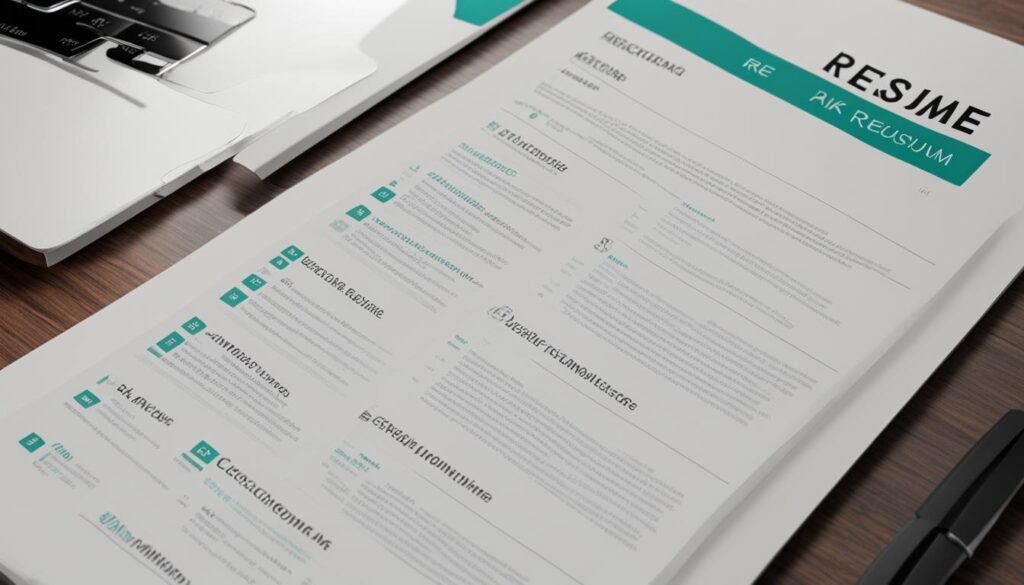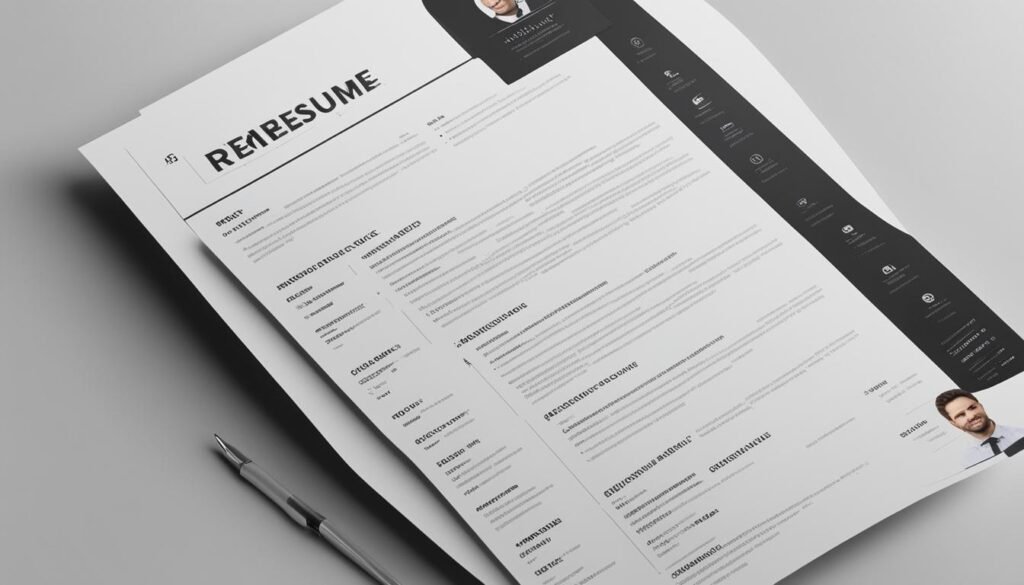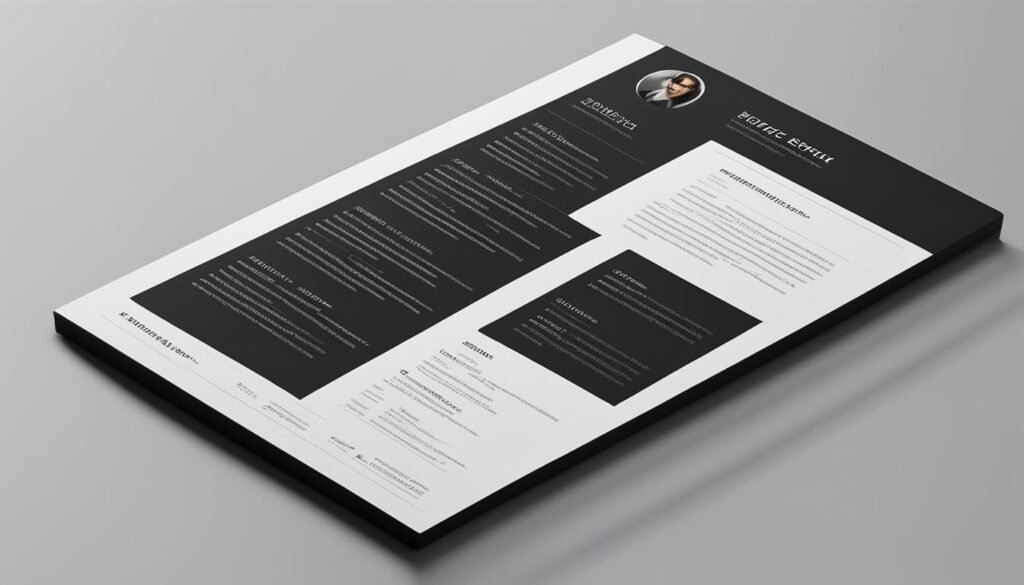A well-written resume is crucial for job seekers to stand out in a competitive job market. It serves as the first impression employers have of candidates and plays a significant role in the hiring process.
According to statistics, an average job opening receives 250 applicants, and only 10% of resumes are seen by the hiring manager. Additionally, 75% of resumes fail to pass the Applicant Tracking System (ATS) due to formatting, content, or lack of keywords.
To craft an effective resume, job seekers should focus on three important elements: clarity and conciseness, demonstrating relevant experiences and skills, and using professional fonts.
Key Takeaways:
- Clarity and conciseness are essential for a well-written resume.
- Demonstrate relevant experiences and skills that align with the job requirements.
- Use professional fonts to enhance the readability and professional appearance of your resume.
- Highlight key achievements and focus on the most impactful experiences.
- Proofread your resume multiple times to eliminate any grammatical or spelling errors.
Clarity and Conciseness
A well-written resume should be clear and concise, providing a focused overview of your qualifications without overwhelming the reader with unnecessary details. To achieve this, it is recommended to keep your resume to one page, although candidates with extensive experience may extend it to two pages. The key is to streamline the content and highlight the most important information that is relevant to the position you are applying for. Focus on using strong action verbs, highlighting your achievements, and removing any irrelevant experiences.
Formatting Tips
- Use bullet points to make your resume more scannable and easier to read.
- Ensure consistent font size and style throughout the document for a cohesive look.
- Organize your resume into clear sections such as education, work experience, and skills.
A well-structured and concise resume allows hiring managers to quickly grasp your qualifications and increases the chances of getting noticed.

Real-Life Example
“Streamlining my resume to focus on only the most relevant experiences and achievements was a game-changer. By removing any unnecessary information, I was able to create a clear and concise document that highlighted my strengths and accomplishments. This approach not only helped me stand out among other applicants but also made it easier for hiring managers to see how I could contribute to their organization.”
Table: Resume Content Checklist
| Section | Content |
|---|---|
| Contact Information | Your full name, phone number, email address, and professional social media profiles (if applicable). |
| Summary/Objective Statement | A brief overview of your skills, experiences, and career goals (optional). |
| Work Experience | Relevant job positions, company names, employment dates, and bullet points highlighting your responsibilities and accomplishments. |
| Education | Degrees earned, institution names, graduation dates, and any academic honors or achievements. |
| Skills | Key skills and competencies that are relevant to the position you are applying for. |
| Certifications/Licenses | Any professional certifications or licenses that are applicable and impressive to the hiring manager. |
| References | Include the phrase “References available upon request” or provide contact information for professional references if requested. |
Demonstrating Relevant Experiences and Skills
When crafting a well-written resume, it is crucial to showcase relevant experiences and skills that align with the job requirements. This section of your resume allows you to demonstrate your qualifications and highlight your suitability for the position. By carefully selecting and emphasizing experiences and achievements that align with the specific role you’re applying for, you can significantly increase your chances of catching the hiring manager’s attention.
To effectively demonstrate relevant experiences and skills, it is important to tailor your resume to fit the job description. Instead of including every job you’ve held, focus on three or four prior experiences that best demonstrate the qualifications needed for the position. Highlight your accomplishments and responsibilities in these roles, showcasing the skills that are directly applicable to the job you’re seeking.
Consider using bullet points to clearly outline your relevant experiences and skills. This format allows hiring managers to quickly and easily identify your qualifications, making it more likely that your resume will stand out among the competition. By presenting your experiences and skills in a concise and organized manner, you can make it easier for employers to see why you are the ideal candidate for the position.

Table: Sample Resume Sections
| Section | Description |
|---|---|
| Summary | A brief overview of your qualifications and career objectives. |
| Work Experience | Details of your previous job roles, including company names, job titles, dates of employment, and key responsibilities. |
| Education | Information about your educational background, including degrees, certifications, and relevant coursework. |
| Skills | A list of your key skills and competencies that are relevant to the job you’re applying for. |
| Achievements | Highlight notable accomplishments and specific results you have achieved in previous roles. |
| References | Provide references who can vouch for your skills and qualifications. |
By including these sections in your resume, you can effectively demonstrate your relevant experiences and skills, giving you a competitive edge in the job market.
Using Professional Fonts
When it comes to crafting a well-written resume, every detail matters, including the choice of font. Using professional fonts not only enhances the readability of your resume but also contributes to its overall professional appearance. The font you choose can have a significant impact on how your resume is perceived by potential employers. It is essential to select a font that reflects professionalism and is easy to read.
Some of the best fonts for resumes include Arial, Helvetica, and Calibri. These fonts are known for their clarity and readability, making them ideal choices for your resume. By using a professional font, you can ensure that your resume looks polished and visually appealing.
Consistency is key when it comes to using fonts in your resume. Maintain the same font style and size throughout the entire document to create a cohesive and visually engaging layout. This consistency not only enhances the readability of your resume but also showcases your attention to detail and professionalism.

In conclusion, using professional fonts is an important aspect of professional resume writing. By selecting a font that is clear and easy to read, maintaining consistency in font style and size, you can create a resume that leaves a positive impression on potential employers.
Highlighting Key Achievements
When crafting a well-written resume, it is important to go beyond simply listing job responsibilities. To make your resume stand out, you should highlight key achievements that demonstrate your skills, accomplishments, and the value you can bring to a potential employer.
By showcasing quantifiable results and specific metrics, you provide concrete evidence of your capabilities. For example, instead of stating that you “managed a team,” highlight that you “led a team of 10 professionals, resulting in a 20% increase in productivity.” This gives hiring managers a clear picture of your contributions and the impact you can make.
Creating a separate section for achievements allows you to emphasize your notable accomplishments even further. This section can include awards, certifications, successful projects, and any other relevant milestones that showcase your skills and expertise. Remember to tailor these achievements to align with the job description and requirements, focusing on those that best highlight your qualifications for the specific role.
| Achievement | Metric |
|---|---|
| Increased sales | Generated a 30% increase in sales revenue within 6 months |
| Streamlined processes | Implemented new workflow system, reducing project completion time by 20% |
| Improved customer satisfaction | Received 95% positive customer feedback based on surveys and ratings |
By highlighting your key achievements, you can differentiate yourself from other candidates and showcase your potential impact on a prospective employer. Remember to use strong language, quantify your accomplishments, and provide specific examples that highlight your skills, expertise, and success.
Proofreading
After crafting your resume, it’s essential to take the time to proofread it thoroughly. Proofreading ensures that your resume is free of grammatical, spelling, or punctuation errors that could detract from its overall professionalism. To start, review your resume multiple times, focusing on different aspects with each pass. Look for any errors in formatting, typos, or inconsistencies.
Aside from your own review, it can also be helpful to seek feedback from trusted friends or coworkers. Fresh eyes can often catch errors that you may have missed. Additionally, consider using proofreading tools or software that can help identify potential mistakes.
A well-proofread resume demonstrates your attention to detail and professionalism. It shows potential employers that you value accuracy and take the time to ensure your work is polished. By taking the extra step to proofread your resume, you increase the chances of making a positive impression on employers and moving forward in the hiring process.

| Proofreading Tips | Definition |
|---|---|
| Review multiple times | Read your resume several times, focusing on different aspects each time |
| Seek feedback | Ask trusted friends or coworkers to review your resume and provide feedback |
| Use proofreading tools | Utilize software or online tools to help identify errors |
| Pay attention to formatting | Check for consistent formatting throughout your resume |
| Check for typos | Look for spelling or grammar mistakes |
| Eliminate inconsistencies | Ensure that details, such as dates and job titles, are accurate and consistent |
Providing Social Media Profiles
When it comes to professional resume writing, listing your social media profiles can be a strategic move. Including platforms like LinkedIn, Twitter, or business blogs can provide employers with a glimpse into your knowledge, passions, and industry involvement. However, it’s essential to ensure that your social media pages are professional and relevant to the position you’re seeking.
By including your social media profiles on your resume, you can showcase additional qualifications or unique insights that may not be fully captured in your resume alone. It allows employers to dive deeper into your professional brand and gain a better understanding of your expertise.

Before including any social media profiles, take the time to review your online presence. Evaluate the appropriateness of the content you’ve shared and ensure that it aligns with the position you’re applying for. Remove any posts or images that may be seen as unprofessional or irrelevant.
Remember, while social media can be a valuable tool in your job search, it’s important to use it strategically and with caution. Be mindful of the information you share and the image you project to potential employers. Keeping your social media profiles professional and industry-focused can add another layer of credibility to your application.
Using Relevant Keywords
When crafting a professional resume, it is crucial to incorporate relevant keywords that align with the job description. Employers and Applicant Tracking Systems (ATS) often use these keywords to filter and shortlist candidates. By strategically incorporating these keywords throughout your resume, you can increase your chances of catching the attention of hiring managers and ATS.
Start by carefully reading the job description and identifying the key qualities and skills that the employer is looking for. These can include specific job titles, industry-specific terminology, and technical skills. Make sure to include these keywords in your resume, particularly in your professional summary, job titles, and skills section.
While it is essential to include relevant keywords, it is equally important to ensure that they are used naturally and appropriately. Avoid stuffing your resume with keywords without any context or relevance. Remember, employers are looking for qualified candidates who can demonstrate their skills and experiences, not just a list of keywords.
By using relevant keywords effectively in your resume, you can showcase your qualifications and increase your chances of getting noticed by employers. However, remember that keywords are just one aspect of a well-written resume. It’s important to have a balanced approach by also focusing on clarity and conciseness, demonstrating relevant experiences and skills, and using professional fonts.

Using Active Language
In order to create an impactful and engaging resume, it is crucial to use active language throughout your document. Active language helps to bring your achievements and experiences to life, capturing the attention of hiring managers and conveying your initiative and ability to drive positive change within an organization.
When writing your resume, focus on using dynamic verbs that showcase your skills and accomplishments. Instead of simply listing your responsibilities at previous positions, use action verbs to describe how you made a difference and achieved results. For example, instead of saying “Responsible for managing a team,” you can say “Successfully led a team of 10 employees, resulting in a 20% increase in productivity.”
In addition to using active language, it is important to quantify your achievements whenever possible. By including specific metrics or results, you provide concrete evidence of your impact and demonstrate your ability to deliver tangible results. This helps employers visualize the value you can bring to their organization and sets you apart from other candidates.
Benefits of Using Active Language in Your Resume
- Captures the attention of hiring managers
- Conveys your initiative and ability to drive positive change
- Highlights your skills and accomplishments
- Demonstrates your ability to deliver tangible results
Remember, your resume is your opportunity to showcase your skills and qualifications to potential employers. By using active language, you can create a resume that stands out and leaves a lasting impression.
Using active language throughout your resume helps to create a compelling narrative of your career story, emphasizing your achievements and showcasing your potential for future success. By following these tips and infusing your resume with energy and passion, you can create a document that grabs the attention of hiring managers and increases your chances of landing your dream job.
| Active Language | Passive Language |
|---|---|
| Achieved a sales target of $1 million | A sales target of $1 million was achieved |
| Initiated and led a successful marketing campaign | A successful marketing campaign was initiated and led |
| Increased customer satisfaction by 20% | Customer satisfaction was increased by 20% |
Table: Examples of Active and Passive Language in Resumes
Conclusion
In today’s competitive job market, a well-written resume is vital to your success. By focusing on professional resume writing and implementing key strategies to enhance your resume format, you can significantly increase your chances of landing your dream job.
Remember, clarity and conciseness are essential. Use strong action verbs and highlight your relevant achievements to grab the attention of hiring managers. Tailor your resume to match the job requirements, demonstrating your skills and experiences that align with the position.
In addition, pay attention to the finer details. Choose professional fonts, proofread your resume multiple times to eliminate any errors, and consider including relevant social media profiles that showcase your professional brand. Incorporate keywords that are appropriate and natural, ensuring your resume stands out to both employers and Applicant Tracking Systems.
Finally, utilize active language to bring your experiences to life. Show your initiative and drive by using dynamic verbs that demonstrate your impact in previous roles. A well-crafted resume serves as your gateway to exciting opportunities and sets you apart from the competition.
FAQ
What are the three important elements of a well-written resume?
The three important elements of a well-written resume are clarity and conciseness, demonstrating relevant experiences and skills, and using professional fonts.
How should I ensure clarity and conciseness in my resume?
To ensure clarity and conciseness, use strong action verbs, highlight relevant achievements, and remove any irrelevant experience. Streamline the content and emphasize the most important points.
How can I demonstrate relevant experiences and skills in my resume?
Carefully select and highlight experiences and achievements that showcase your qualifications for the specific role you’re applying for. Tailor the resume to fit the job description and focus on three or four prior experiences that best demonstrate the qualifications needed for the position.
What fonts should I use in my resume?
Choose professional fonts like Arial, Helvetica, or Calibri, known for their clarity and readability. Maintain consistency in font size and style throughout the resume to create a cohesive and visually appealing layout.
How should I highlight key achievements in my resume?
Instead of simply listing job responsibilities, highlight your top three or four accomplishments for each position. Include metrics or specific results to showcase your contributions and the value you can bring to the role. Consider creating a separate section for achievements or skills.
Why is proofreading important in resume writing?
Proofreading ensures there are no grammatical, spelling, or punctuation errors in your resume. Review your resume multiple times and ask for feedback from trusted friends or coworkers. A well-proofread resume shows attention to detail and professionalism.
Should I include social media profiles on my resume?
Listing social media profiles can be beneficial if they support your professional brand. Platforms like LinkedIn, Twitter, or business blogs can highlight your knowledge, passions, and involvement in your industry. However, ensure that your social media pages are professional and relevant to the position you’re seeking.
How do I incorporate relevant keywords in my resume?
Carefully read job descriptions and include terms that indicate the qualities valued by the employer. Align your resume with the job description to improve the chances of it being noticed by Applicant Tracking Systems (ATS) and hiring managers. Use natural and appropriate keywords that highlight your background and experiences.
Why is using active language important in a resume?
Active language brings achievements and experiences to life. Use dynamic verbs and active language to convey your involvement and impact, rather than simply listing responsibilities. This catches the attention of hiring managers and demonstrates your initiative and ability to drive positive change within an organization.
How important is a well-written resume in the job market?
A well-written resume is crucial for job seekers to stand out in a competitive job market. It serves as the first impression employers have of candidates and plays a significant role in the hiring process. Crafting a well-written resume increases the chances of landing a dream job.
